Problem Solving Using Rates, Unit Rates, and Conversions
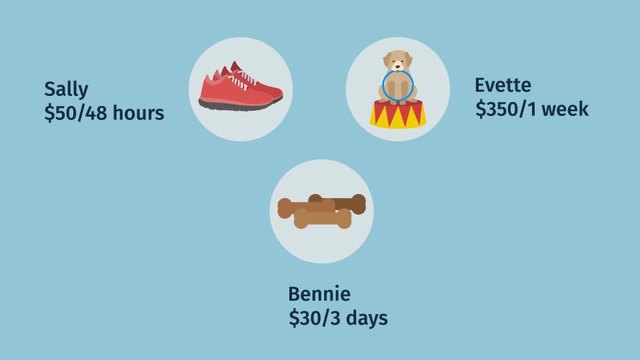

Basics on the topic Problem Solving Using Rates, Unit Rates, and Conversions
After this lesson, you will be able to solve real world problems involving rates, unit rates, and conversions.
The lesson begins by teaching you that rates can be combined once they have common units and reduced to unit rates. It leads you to learn how to convert units and reduce rates to unit rates. It concludes by showing you how to solve rate problems involving unit pricing.
Learn about rates, unit rates, and conversions by helping Sally, Bennie, and Evette solve their issues regarding animal rescue.
This video includes key concepts, notation, and vocabulary such as the term rate (a ratio that compares two quantities having different units of measure); unit rate (a ratio of a quantity to one of another); conversion factor (a ratio between two units with equal values and usually used to convert units from one to another); and unit price (a cost per unit of something you want to buy)
Before watching this video, you should already be familiar with ratio, unit rate, and converting measurements, like weeks to days, pounds to kilograms, etc.
After watching this video, you will be prepared to learn solve real world problem involving unit pricing and constant speed. You will also be prepared to learn how to manipulate and transform units appropriately when multiplying or dividing quantities.
Common Core Standard(s) in focus: 6.RP.A.3.B and 6.RP.A.3.D A video intended for math students in the 6th grade Recommended for students who are 11 - 12 years old
Transcript Problem Solving Using Rates, Unit Rates, and Conversions
Sally, Bennie, and Evette are friends who live in the 'burbs.
One day on their way home from school, they hear whimpering from a box on the sidewalk.
In the box they find 3 abandoned puppies.
They bring the puppies home, and try to contact their local animal shelters, but all of them are full. What now?
Sally suggests they start their own animal rescue, Ruff Rescue.
Starting an animal rescue involves various issues including fundraising rates and pet food comparisons.
In order to help the friends solve these issues we can apply problem-solving using rates, unit rates, and conversions.
First, Ruff Rescue needs to raise money to pay for all the food and supplies that they want to purchase.
The three friends come up with different ideas about how to fundraise.
Sally creates an online fitness challenge where she raises money for every mile she runs and posts the video online.
Her efforts get some attention, and Sally raises 50 dollars every 48 hours - hashtag puppylove!
Bennie likes making treats for our four-legged friends.
By selling them he raises 30 dollars in 3 days, what a treat!
Evette teaches the puppies some tricks and has the puppies perform the tricks in the park.
She earns 350 dollars a week, a spectacular performance!
At this rate how much money are the friends earning?
We can’t just combined the numbers because each friend is counting the money differently.
What rate unit could we use for all of them?
Dollars per day is a good option.
We already have dollars for each friend.
We just need to change the time to days.
Looking at Sally's fundraising efforts, 48 hours is 2 days.
So, that’s 50 dollars every 2 days.
Can we convert that to a unit rate to get the denominator as one day?
Yes, reducing the ratio by dividing by 2 gives us the unit rate of 25 dollars per day, strong work!
Bennie's rate unit is already dollars per days.
To get his unit rate of dollars per day all we need to do is reduce the fraction, giving us 10 dollars per day--every little bit of kibble helps!
Evette’s puppy performance earns 350 dollars per week, which is 350 dollars in 7 days.
Reducing gives us 50 dollars per day!
Looks like those puppy tricks are raking in the most dough!
Nevertheless, each of their fundraising efforts matter.
So, to find out what they can make together let's combined their unit rates by adding the fractions.
The denominators are all the same so adding the numerators results in 85 dollars per day.
A good start to their fundraising efforts allows the friends to now research different dog food options.
There are two brands they are considering
Doggy Delight costs 25.49 for 1.3 kilograms, and it's all natural with extra protein and calcium to strengthen muscles and bones.
Bennie Bite is 22.79 for 3 lbs. It's Bennie’s homemade, organic, preparation that the puppies just love.
At Ruff Rescue the friends only want to give the best quality to their pups.
Nevertheless, they've got to keep an eye on their budget.
Therefore, the friends would like to know which option is the least expensive.
In order for us to see this clearly, let’s convert the units for each price to the unit rate of dollars per pound.
How can we convert Doggie Delight to dollars per pound?
By converting the units using a conversion factor.
Is there a conversion factor which relates pounds to kilograms?
Yes! 1 kilogram is about two point two pounds.
We put kilograms on top of the conversion factor to cancel with kilograms on the bottom of our original rate unit, leaving us with dollars per pound.
Multiplying through the numerator gives us 25 dollars and 49 cents and also across the denominator gives us 2.86 pounds.
Then, using our calculator, we calculate the unit rate by simply dividing.
This results in a unit rate of approximately 8.91 dollars per pound.
Now we can find the unit rate of Bennie Bite.
Bennie already sells his dog food in three pound packages.
So to get the unit rate of dollars per pound we just divide by 3.
That results in about 7.60 per pound.
Bennie's dog food is the best value for Ruff Rescue.
Helping puppies is a problem we solved with the use of rates, unit rates, and unit conversions.
First we converted the different fundraising rates to a common rate unit, dollars per days.
Next, in order to combine the rates we simplified each one to a unit rate using division so the denominator would be one.
In the second example, we wanted to compare dog food prices.
So, we used a conversion factor to represent each brand with a rate unit of dollars per pounds.
Then, we simplified them using division to give us the unit prices.
All of these steps can be used in various ways to solve problems involving rates and in this case, to help Ruff Rescue get started.
The friends make a poster encouraging people to adopt.
But... oh man. Looks like the friends will need to spend some more time training the puppies.
They’ve got their work cut out for them.
Hashtag Hungry Puppies!
Problem Solving Using Rates, Unit Rates, and Conversions exercise
-
Utilize rate to compare and solve a work problem.
HintsA unit rate is expressed as a quantity of $1$.
If Sally makes $$84$ in $2$ hours, divide both numbers by $2$ to find that she makes $$42$ in $1$ hour or $$42$ per hour.
Bennie makes $$192$ in $4$ days.
- To convert to the unit rate dollars per hour, multiply $4$ days by $24$ hours to find that $4$ days equals $96$ hours.
- We can now see that Bennie makes $$192$ in $96$ hours.
- Dividing both sides by $96$ yields the unit rate $$2$ per hour.
Solution1. Since each friend is counting their money differently, we need to choose one time period (hour, day, week, month, year) as the unit.
Sally's units are dollars per hour, Bennie's units are dollars per day, and Evette's units are dollars per week.
The best unit rate to choose for this scenario is dollars per day, since the number can be easily converted into dollars per day.
2. Sally walks dogs and makes$$75$ in $72$ hours. This is the same as$$75$ in $3$ days because $72$ hours divided by $24$ hours equals $3$ days. Now we can convert to a unit rate to find how much Sally makes in one day. We can divide both sides by $3$ and find that Sally makes$$25$ per day.
3. Bennie works at the local pet store and makes$$200$ in four days. To find the unit rate, divide both sides by $4$ to find that Bennie makes$$50$ per day.
4. Evette teaches puppy school and makes$$420$ in one week. This is the same as$$420$ in $7$ days. The unit rate is found by dividing both sides by $7$. Evette makes$$60$ per day.
5. Now that everything is represented in the same unit, we can add them together:
- $$25$ per day $+$$$50$ per day $+$$$60$ per day $=$$$135$ per day.
-
Compare using a unit rate.
HintsA unit rate is expressed as a quantity of $1$.
To find a unit rate, divide both numbers in the ratio by the second number.
It costs $\$16.50$ for $5$ dog bones. Find the unit rate by dividing both numbers by $5$. It costs $\$3.30$ per dog bone.
SolutionTo find a unit rate, divide by the dollar amount by the number of items.
1.$\$29.49$ for $95$ dog treats
- Divide both numbers by $95$
- $\$0.31$ per dog treat.
- Divide both numbers by $9$
- $\$2$ per rubber ball.
- Divide both numbers by $8$
- $\$4.06$ per dog bone.
- Divide both numbers by $4$
- $\$4.99$ per dog brush.
- Divide both numbers by $6$
- $\$8.49$ per teddy bear.
- Divide both numbers by $5$
- $\$10.55$ per bag of dog food.
-
Identify the work problems that can be solved by finding a rate.
HintsWork problems can be solved by finding a unit rate, and non-work problems don't involve unit rates.
A unit rate is expressed as a quantity of $1$.
An example of a work problem is:
Tony and Sofie are partners for a class project. In the past, Tony completed $3$ projects in $6$ hours, and Sofie completed $4$ projects in $2$ hours. How long will it take Tony and Sofie to complete one project together?
SolutionWork Problems: Problems that are solved by finding a unit rate.
1. Two painters, Sam and Marcus, are hired to paint a new apartment. Sam can paint $3$ houses in $24$ hours, and Marcus can paint $2$ houses in $20$ hours. Which painter paints at a faster rate?
- Since the answer to this problem requires you to solve for a unit rate, it is considered a work problem.
- Set up a fraction to represent the work: $\frac{3\text{ houses}}{24\text{ hours}}$ and $\frac{2\text{ houses}}{20\text{ hours}}$
- Divide the numerator by the denominator to find the unit rate: $\frac{0.125\text{ houses}}{1\text{ hour}}$ and $\frac{0.1\text{ houses}}{1\text{ hour}}$
- Since $0.125$ houses per hour is greater than $0.1$ houses per hour, Sam paints at a faster rate than Marcus.
- Since the answer to this problem requires you to solve for a unit rate, it is considered a work problem.
- Set up a fraction to represent the work: $\frac{4\text{ driveways}}{8\text{ hours}}$ and $\frac{5\text{ driveways}}{7.5\text{ hours}}$
- Divide the numerator by the denominator to find the unit rate: $\frac{0.5\text{ driveways}}{1\text{ hour}}$ and $\frac{1.5\text{ houses}}{1\text{ hour}}$
- No. Since $0.5$ driveways per hour is less that $1.5$ driveways per hour, Malia shovels at a slower rate than Kate.
- Since the answer to this problem requires you to solve for a unit rate, it is considered a work problem.
- Set up a fraction to represent the work: $\frac{25\text{ flowers}}{45\text{ minutes}}$ and $\frac{17\text{ flowers}}{38\text{ minutes}}$
- Divide the numerator by the denominator to find the unit rate: $\frac{0.56\text{ flowers}}{1\text{ minute}}$ and $\frac{0.45\text{ flowers}}{1\text{ minute}}$
- Yes. Since $0.56$ flowers per minutes is greater that $0.45$ flowers per minute, Kroy plants faster than Edmond.
1. Ray and Rob are planning a road trip. Last year it took them $5.5$ hours to drive $275$ miles. How long will it take them to drive $350$ miles?
- Since the answer to this problem requires you to solve for a ratio and not a unit rate, it is not considered a work problem.
- To solve this type of word problem we need to set up a proportion: $\frac{5.5\text{ hours}}{275\text{ miles}}=\frac{x\text{ hours}}{350\text{ miles}}$
- Cross multiply: $275x=5.5(350)$
- Simplify: $275x=1,925$
- Solve: $x=7$
- Therefore, it will take $7$ hours to drive $350$ miles.
- Since the answer to this problem requires you to solve for a ratio and not a unit rate, it is not considered a work problem.
- There are $22$ red and blue marbles in the bag, and a total of $50$ marbles.
- To find the percentage of red and blue marbles, divide $22$ by $50$, then multiply by $100$: $(22\div 50)\cdot 100=44$
- $44\%$ of the marbles are red and blue.
-
Solve unit rate word problems.
HintsA unit rate is expressed as a quantity of 1.
To find the unit rate, set up a fraction to represent the situation, then divide the numerator by the denominator.
- The unit rate for $8$ miles in $32$ minutes is represented by the fraction $\frac{8\text{ miles}}{32\text{ minutes}}$.
- Divide the numerator by the denominator: $\frac{0.25\text{ miles}}{1\text{ minute}}$
- Therefore, the unit rate is $0.25$ miles per minute.
SolutionIn the following problems, to find the unit rate, set up a fraction to represent the situation, then divide the numerator by the denominator.
1. Audrey and Kai are on a road trip. Audrey drives $315$ miles in $5$ hours, and Kai drives $243$ miles in $4.5$ hours.
- Audrey drives $63$ miles per hour ($\frac{315\text{ miles}}{5\text{ hours}}=\frac{63\text{ miles}}{1\text{ hour}}$), and Kai drives $54$ miles per hour ($\frac{243\text{ miles}}{4.5\text{ hours}}=\frac{54\text{ miles}}{1\text{ hour}}$).
- Who drives faster, Audrey or Kai? Audrey because 63 miles per hour is greater than 54 miles per hour.
- Order the girls from the slowest to the fastest rate for collecting eggs: Sofie, Mady, Ada.
- Ada collected her eggs at a rate of 0.65 eggs per minute: $\frac{15\text{ eggs}}{23\text{ minutes}}=\frac{0.65\text{ eggs}}{1\text{ minute}}$
- Sofie collected her eggs at a rate of 0.9 eggs per minute: $\frac{19\text{ eggs}}{21\text{ minutes}}=\frac{0.9\text{ eggs}}{1\text{ minute}}$
- Mady collected her eggs at a rate of 0.68 per minute: $\frac{17\text{ eggs}}{25\text{ minutes}}=\frac{0.68\text{ eggs}}{1\text{ minute}}$
- What is the unit rate for the box of $9$ tomatoes rounded to the nearest hundredth? $2.25$ tomatoes per dollar because $\frac{9\text{ tomatoes}}{\$3.99}=\frac{2.25\text{ tomatoes}}{\$1}$.
- Is the box of $11$ tomatoes a better deal than buying the box of $9$ tomatoes? No because the unit rate for box of $11$ tomatoes is $2.10$ tomatoes per dollar ($\frac{11\text{ tomatoes}}{\$5.25}=\frac{2.10}{\$1}$)
- Sarah ran at a rate of $5.2$ miles per hour on Saturday. Convert minutes to hours by dividing by $60$: $57.5\div 60=0.96$. Now, find the unit rate: $\frac{5\text{ miles}}{0.96\text{ hours}}=\frac{5.2\text{ miles}}{1\text{ hour}}$
- Which day did Sarah run at a faster rate, Saturday or Sunday? Sunday because $\frac{8\text{ miles}}{1.44\text{ hours}}=\frac{5.56\text{ miles}}{1\text{ hour}}$
-
Convert simple units.
HintsThere are $12$ inches in $1$ foot, and $2.54$ centimeters in $1$ inch.
$7$ feet are $84$ inches.
$7$ feet are $213.36$ centimeters.
SolutionThere are 12 inches in 1 foot, and 2.54 centimeters in 1inch. To convert feet to inches, multiply by 12. To convert feet to centimeters, first multiply by 12, then by 2.54.
5 feet
- There are 60 inches in 5 feet: $5(12)=60$
- There are 152.4 centimeters in 5 feet: $5(12)(2.54)=152.4$
- There are 69 inches in 5.75 feet: $5.75(12)=69$
- There are 175.26 centimeters in 5.75 feet: $5.75(12)(2.54)=175.26$
- There are 72 inches in 6 feet: $6(12)=72$
- There are 182.88 centimeters in 6 feet: $6(12)(2.54)=182.88$
- There are 78 inches in 6.5 feet: $6.5(12)=78$
- There are 198.12 centimeters in 6.5 feet: $6.5(12)(2.54)=198.12$
-
Identify the correct solutions to the word problem.
HintsTo find the unit rate, set up a fraction to represent the situation, then divide the numerator by the denominator.
There are $36$ inches in $1$ yard.
There are $3$ feet in $1$ yard.
SolutionTo find the unit rate, set up a fraction to represent the situation, then divide both the numerator and denominator by the denominator.
Since all of the answer choices are represented in yards, convert the fabrics that are listed in inches and feet to yards.
There are $3$ feet in $1$ yard and $36$ inches in $1$ yard.
The unit rates are as follows:
1. Flannel Fabric: $\$27.96$ for $4$ yards
- $\frac{\$27.96}{4\text{ yards}}=\frac{\$6.99}{1\text{ yard}}$
- The unit rate is $\$6.99$ per yard.
- $\frac{\$24.97}{90\text{ inches}}\cdot \frac{36\text{ inches}}{1\text{ yard}} =\frac{\$898.2}{90\text{ yards}}=\frac{\$9.99}{1\text{ yard}}$
- The unit rate is $\$9.99$ per yard.
- $\frac{\$30.31}{7\text{ feet}}\cdot \frac{3\text{ feet}}{1\text{ yard}} =\frac{\$90.93}{7\text{ yards}}=\frac{\$12.99}{1\text{ yard}}$
- The unit rate is $\$12.99$ per yard.
- $\frac{\$29.96}{3.75\text{ yards}}=\frac{\$7.99}{1\text{ yard}}$
- The unit rate is $\$7.99$ per yard.
- Fleece Fabric costs $\$1$ more per yard than Flannel Fabric. This is correct because $\$7.99-\$6.99=\$1$.
- The unit rate for Quilt Fabric is $\$9.99$ per yard.
- The total cost for $1$ yard of Satin Fabric and $1$ yard of Fleece Fabric is $\$20.98$. This is correct because $\$12.99+\$7.99=\$20.98$.
- The total cost for 1 yard of all 4 fabrics is $\$37.96$. This is correct because $\$6.99+\$9.99+\$12.99+\$7.99=\$37.96$.
- The unit rate for Flannel Fabric is $\$7.99$ per yard.
- The unit rate for Satin Fabric is $\$6.99$.

From Ratios to Rates and Rates to Ratios
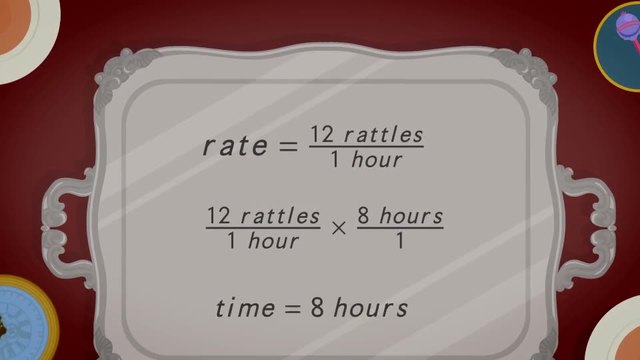
Finding Rates with Division
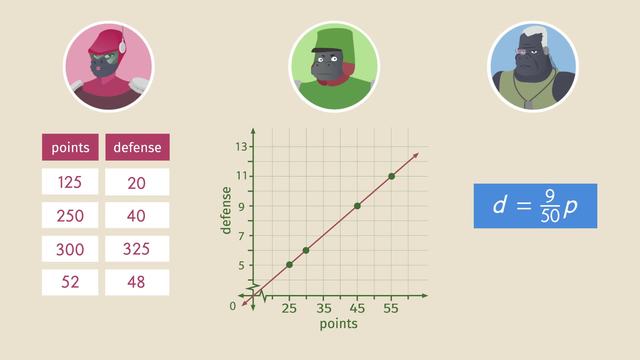
Comparison Shopping: Unit Price and Related Measurements

Getting the Job Done—Speed
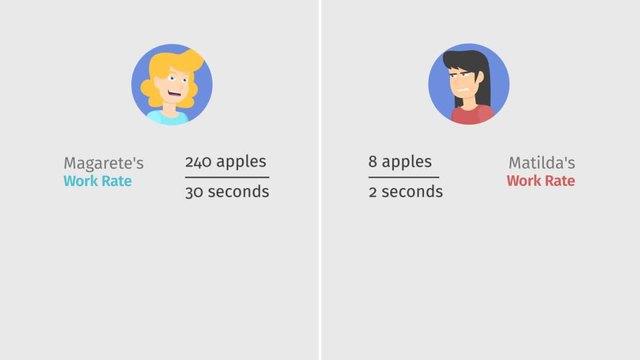
Getting the Job Done—Work
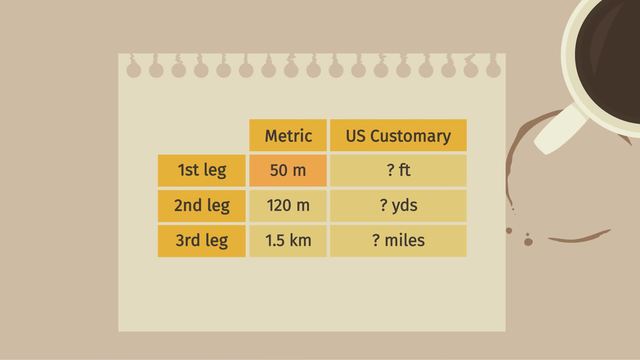
Getting the Job Done: Converting Units of Measurement

Problem Solving Using Rates, Unit Rates, and Conversions
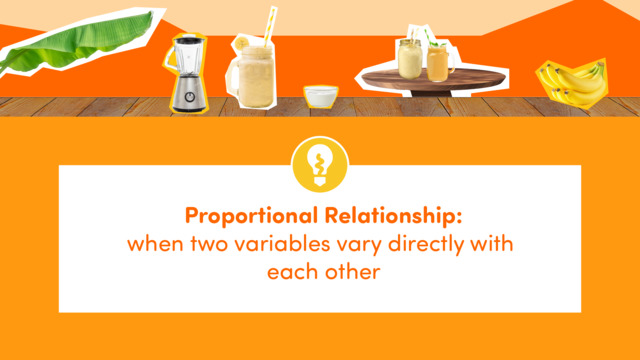
What is a Proportional Relationship?











